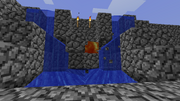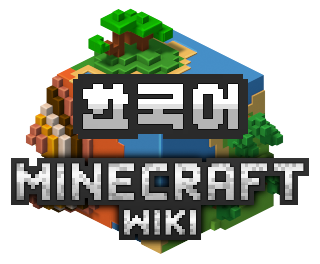
조약돌 농사 는 조약돌 생성기 를 사용해 땅을 파지 않고 조약돌을 얻는 방법입니다. 조약돌 생성기는 흐르는 용암이 물과 만나 조약돌이 되는 원리를 사용합니다. 이때 흐르는 용암은 조약돌로 바뀔 것입니다. 이 조약돌은 용암과 물이 서로 맞닿는 것을 막을 것입니다. 조약돌이 없어졌을 때, 다시 용암과 물이 만나 조약돌로 변할 것입니다.
생성기를 만드는 방법에는 여러가지가 있습니다. 그러나 가장 간단한 방법은 10블록 길이의 구멍의 맨 끝에 물을 설치한 다음, 반대편에는 용암을 두는 것입니다. 이것은 조약돌을 용암 옆에 생성되게 합니다.
여기서 주의점은 흑요석이 생기지 말도록 해야 합니다. 그것은 용암 소스 블록이 물과 바로 닿을 경우에 일어납니다. (흑요석의 농사는 튜토리얼/여기 를 참고하세요.) 기초적인 액체의 성질을 아는 것이 이것을 막는데 도움이 될 것입니다.
일반적인 조약돌 생성기
일반적인 생성기 는 쉽게 만들 수 있어 인기가 많습니다.하지만, 조약돌의 생산량이 적어서 용도가 제한적입니다. 일반 생성기들은 플레이어가 새로 생성되는 조약돌을 캐는 방법으로 조약돌을 얻습니다. 이 생성기로 조약돌을 모을때의 주요한 문제는 캐어진 조약돌이 용암으로 빠져 사라질 수 있다는 것입니다. 조약돌이 재생 가능한 자원이지만, 이것은 굉장히 효율을 낮춥니다.
예제:
이것은 조약돌 대신 돌 생성기를 사용하고 피스톤을 이용해 캐어진 돌이 용암으로 빠지지 않고 안전히 캘 수 있도록 한 방법 중 하나입니다.
- ZirumsHeroTWR's Cobblestone "Factory" Version 1
- ZirumsHeroTWR's Cobblestone "Factory" Version 2
- ZirumsHeroTWR's Cobblestone "Factory" Version 3
This generator design accomplishes a consistent flow of four cobblestone blocks for every fourth piston pumping cycle. The four blocks are generated from the ground going upwards, negating any chance of the cobblestone burning from touching lava.
- — Version Comparisons —
- Version 1 — 5x5 Area, most simple design.
- Version 2 — 3x5 Area, less Redstone used.
- Version 3 — 3x4 Area, bug fixes, less resources needed.
It is suggested to use obsidian blocks behind the lava source blocks, as this will stop you from accidentally mining a hole in the back wall.
This design features a lower chance of the cobblestone being destroyed by lava, but it is significantly larger.
피스톤 조약돌 생성기
Piston은 조약돌 생성기를 자동화하는데 쓸 수 있다. 피스톤 조약돌 생성기는 일반적인 생성기와 같은 원리로 작동하지만 피스톤이 조약돌이나 돌을 직선으로 나오게 해서 한 번 더 채굴할 수 있게 해준다. 피스톤 조약돌 생성기는 두 가지 방법으로 쓸 수 있는데, 플레이어가 나중에 채굴할 수 있는 많은 조약돌을 공급하거나, 블록으로 두어서 자동으로 수리되는 구조물을 만들 때도 쓸 수 있다.
[1] 를 클릭하면 아주 간단한 자동 조약돌 생성기 튜토리얼을 볼 수 있다.
1.9 부터는, 용암이 위로부터 물로 떨어지면 일반 stone. 돌은 조약돌보다 조금 더 빠르게 캘 수 있으며, 또 섬세한 손길 enchantment를 사용하여 일반 돌을 얻을 수 있고, 자동으로 수리되는 구조물을 더 자연스럽게 보이도록 할 수 있다.
Components
There are three basic components to consider in a piston cobblestone generator:
- The Core. This part includes the water and lava that creates the fresh cobblestone.
- A clock generator. This part sends a pulse to the piston that pushes fresh cobblestone out.
- Optionally, Secondary Pistons. These parts move the fresh cobblestone further, allowing for more cobblestone to be generated.
The Core
Stone-generating core surrounded by glass.
Cobblestone-generating core surrounded by glass.
The piston pushing the stone/cobblestone is always non-sticky.
This part can be very similar to standard cobblestone generators. The lava and water mix in front of the piston. One thing to consider is that the piston must be accessible by redstone. There is a hole at the end of the water stream which draws the water straight. When attached to a redstone clock, this will create a single row of cobblestone 13 blocks long (since the limit a piston can push blocks is 12 blocks).
The stone generator is rarely used without pistons, as lava needs to be directly above the stone generated. Lava must flow down into water flowing in front of the piston. Like cobblestone generators, it will make a row of stone up to 13 blocks long.
Redstone Clock Generator
Simple redstone pulse-generating clock. Repeater delays are 3-3-3.
A basic understanding of redstone is helpful but not necessarily required.
The ideal clock will send a pulse shortly after the stone/cobblestone has been created, making way for a new piece of stone/cobblestone. The generator can be toggled by placing a lever on the side of the block with the redstone torch.
This simple clock is created by placing a redstone torch onto the side of a block, with a piece of redstone dust on the direct opposite of this block. Note that the redstone torch must be attached to the side of the same block that will have the diode on it. The diode should have a maximum delay for a cobblestone generator. The connection to the pistons can branch off the redstone torch or dust.
Sample side view of the clock required for a generator:
l x - d - x r - x - y x - x - x (Ground)
x: a covering block such as dirt or stone d: a diode/repeater r: redstone torch y: redstone dust l: lever
note: the dashes do not represent spacings
Secondary Pistons
Since pistons can only push a maximum of 12 blocks, the core will only produce a limit of 13 cobblestone blocks. This can be greatly increased with secondary pistons that guide the row of cobblestone in other directions. In a way, it is a similar idea as the core piston in that it removes the fresh cobblestone in order for more to be created. Self repairing structures tend to use several secondary pistons and one or two cores.
Triggering a secondary piston can be done a few ways. The secondary pistons can be connected to the same redstone clock as the core, which periodically extend the piston. This can be annoying if you are working in the area as pistons make considerable noise. Alternatively, a Redstone Repeater can send a signal through the block which detects when a piece of cobblestone is present. This can then send a signal to a line of secondary pistons which trigger simultaneously.
How to make a smooth stone generator
This is simple to make and 90% efficient. You need these items -lava bucket -water bucket -a lot of dirt(or any other block thats not flammable)
Now its time to get started:
Make a 5x5 area out of dirt, hollow it out, put water on the bottom and put lava on the top. The stone blocks will spawn 1 block above the water.
For a collection area, remove the dirt block on the corner that the water flows to.
Video Tutorials/Examples
Self-Repairing Fast Smooth-stone Generator Tutorial. It is automatic, repairing, Very fast, and from what I have seen is actually 110% effective because smooth stone breaks faster than cobblestone. This is highly recommended.
This design is the easiest to build and the most basic. It is simply lava and water placed in the ground with a place to mine the cobble from.
This design offers a completely covered and compact version of a cobblestone farm. This design's size should minimize possible lag and includes a switch, to control production.
This design is a very efficient cobble generator, doesn't lag your game, is very small, and fairly easy to build. Unlike others, this version has a built-in failsafe, so it never breaks.
This uses a four sided repeater clock, but with uneven delay. The piston is retracted 5/6th of the cycle.
This compact design triggers when cobblestone is generated rather than using an external clock which means it provides the player fresh cobblestone much faster.
This Generator is the version for Smooth Stone without clock for enhanced speed and reduced lag. (Smooth Stone can be mined faster, too)
This shows how secondary pistons move the row of cobblestone from the core. They trigger at every clock cycle.
This shows how signals can go through solid blocks using repeaters. This will trigger independently of a central clock and is a viable way of setting up secondary pistons to minimize noise.
This generator uses no redstone and is quite efficient. It works using the 'tight' spacing block on the fence to let the cobblestone fall, while keeping you up.
